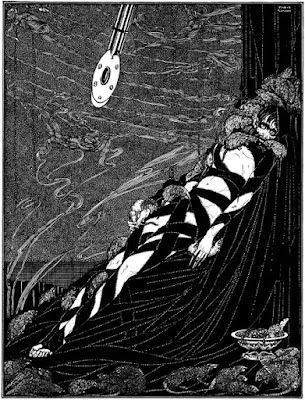Copyright 2019 by Gary L. Pullman
Warning! Do not read this article unless you have a strong stomach!
Click the image to enlarge it.
Stark, horrific, and
grotesque, the sets of statues are warnings to the faithful. In no
uncertain terms, the sculptures show the fates of those whose bad
karma caused them to be born in a place of long-term, but not
eternal, torment in a layers of Naraka, the Buddhists' hell.
Click the image to enlarge it.
In one set of sculptures,
skeletal figures are marched, chained together in single file, their
bloody arms, spines, buttocks, and legs exhibiting holes that have
been punched into them, toward a gigantic bowl-shaped pan atop
skulls. A fire under the pan indicates its purpose: to cook the
unfortunates who climb into the pan, unfurling long tongues as they
dance in the burning vessel or lie with their arms folded over the
pan's rim. Dark-skinned guards, armed with spears and sticks, guard
the damned. One of guards lifts a cursed male figure over his head,
ready to toss him into the pan with the others who share his doom.
Click the image to enlarge it.
Naraka
is somewhat similar to the hell of Chinese mythology, upon which
Naraka itself is based. Although the numbers of the layers, or
courts, of the labyrinthine underworld differ among sources, some
stating that there are three or four courts, others that there are
ten, still another that there are eighteen, and yet others that there
are thousands, the chief source for Naraka claims that there are
Eight Cold Narakas and Eight Hot Narakas. Each has its unique form of
punishment, several of which are depicted by the statues.
Click the image to enlarge it.
Some of the punishments of
the Cold Narakas include suffering from blisters, experiencing
splitting skin, and having the body itself crack open and expose the
victims' internal organs, which also crack apart.
Click the image to enlarge it.
Among the torments of the
Hot Narakas are being attacked with iron claws and fiery weapons,
being showered with molten metal, being sliced into pieces, and
having to walk and lie on the heated ground. Guards cut bodies into
pieces with fiery saws and axes. The damned are crushed by rocks,
burned alive, eaten by wild animals, impaled upon fiery spears,
pierced by a trident, and roasted alive.
Each punishment, in both
the Cold Narakas and the Hot Narakas, lasts from hundreds of millions
to sextillions (1021)
of years, and each lifetime in a Naraka lasts eight times longer than
the previous one.
Click the image to enlarge it.
Some of the statues depict
the suffering that the damned encounter in Diyu,
the Chinese hell (or hells); others seem to portray the plight of the
condemned in the Narakas. Among the former punishments are suggested
by the names of a concept of Diyu as comprising eighteen hells: Hell
of the Hanging Bars, Hell of the Pit of Fire, Hell of Tongue Ripping,
Hell of Skinning, Hell of Grinding, Hell of Pounding, Hell of
Dismemberment by Vehicles, Hell of Ice, Hell of Disembowelment, Hell
of Oil Cauldrons, Hell of the Mountain of Knives, among them.
Click the image to enlarge it.
Some scenes involving the
statues do not seem to match the descriptions in Buddhist scriptures
concerning the nature of the Narakas, in which case the sculptures
may, instead, represent various other hells in the Chinese Diyu. With
thousands of hells, each group of statues likely represents one of
the many places of Chinese, if not specifically Buddhist, torment.
Click the image to enlarge it.
The sculptors are not
timid in displaying the flesh of the damned, and there is even some
grim humor in the displays of some of the figure's torments,
especially when the punishments apparently are for the commission of
taboo sexual acts or harboring forbidden appetites of the flesh.
Phalli, for example, are sometimes of gargantuan size, as if the
organs, as symbols of prurient desire, weigh down those who bear
them. One male figure appears unable to stand erect, because the
enormous size and weight of his phallus causes him to stoop at all
times. Another male figure also stoops, carrying his flaccid organ
over his shoulder as he shuffles along, past a female figure whose
bloody vulva is being consumed by a dog while another male figure,
whose thoughts have too much been occupied by sexual fantasies,
perhaps, looks on, as it were, his phallus having replaced his neck
and head.
Click the image to enlarge it.
Oddly, the Asian figures
are bright white; the only parts of their bodies to be represented in
color are those of their sex organs: one male's is reddish brown; the
others' members are dark brown. The female figure's vulva is red with
the blood flowing from her half-devoured organs. The absence of
colors except in regard to their sexual parts is intended, perhaps,
to make their colorful, offending organs stand out all the more, by
way of contrast.
Click the image to enlarge it.
Images of mutilation,
impalement, distension, anatomical displacement (eyes in elbows and
replacing nipples, a fanged mouth or a complete face in an abdomen),
grinding, devouring, decapitation, hacking, disembowelment, tongue
ripping, spearing, knifing, pressing, roasting, physical
transformation, hooking, and dismemberment make it clear that
Buddhism is not simply the mellow, intellectual, contemplative
discipline that it is often portrayed as being and is often
understood, especially by Westerners, to be. These statues testify to
the fact that there is also a darker, brutal, sadomasochistic, and
decidedly more sinister side to Buddhist tradition, doctrines, and
beliefs.
Click the image to enlarge it.































